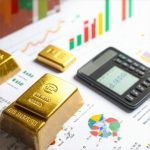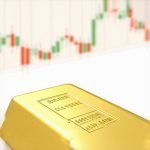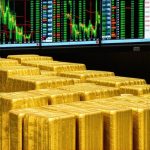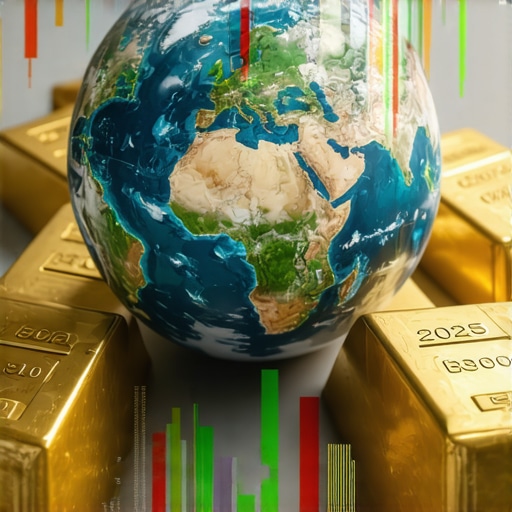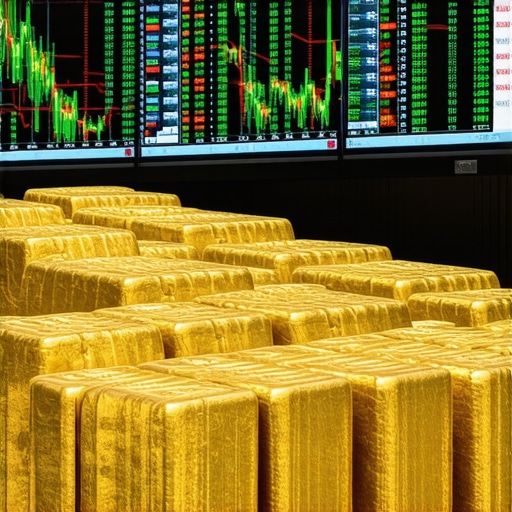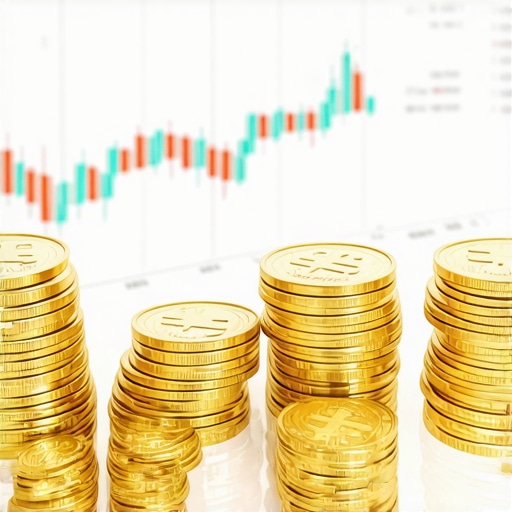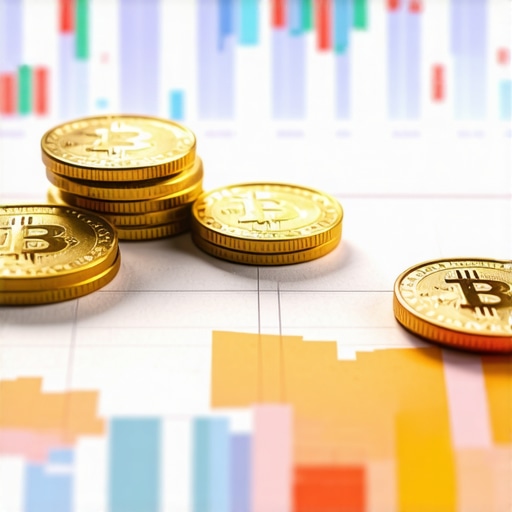Understanding the Nexus Between Global Economics and Gold Valuation in 2025
As an authority in financial analysis, I recognize that the trajectory of gold prices in 2025 will be profoundly influenced by a complex interplay of macroeconomic variables. These factors embody the pulse of the world economy, reflecting shifts in monetary policies, geopolitical tensions, and emerging market dynamics. This article delves into the nuanced mechanisms through which global economic factors will drive gold prices, providing a comprehensive perspective for investors and policymakers alike.
Key Economic Drivers Impacting Gold in 2025
Monetary Policy and Central Bank Gold Purchases
The stance of major central banks—particularly regarding interest rates and gold reserves—will significantly shape gold’s market performance. As outlined in recent analyses by the International Monetary Fund (IMF), central banks’ gold purchases are expected to increase as part of diversification strategies amidst currency fluctuations. These purchases can exert upward pressure on gold prices, especially during periods of unconventional monetary easing.
Global Inflation Trends and Real Interest Rates
Inflation remains a pivotal factor. When inflationary pressures surge without commensurate interest rate hikes, gold often acts as a hedge, rallying in value. Conversely, rising real interest rates tend to diminish gold’s appeal, as the opportunity cost of holding non-yielding assets increases. The delicate balance between inflation expectations and monetary policy adjustments will be critical in 2025.
Geopolitical Uncertainties and Safe-Haven Demand
Geopolitical tensions—ranging from trade conflicts to regional conflicts—tend to elevate gold’s status as a safe haven. The escalation of such issues, compounded by unpredictable policy responses, can trigger volatility in traditional financial markets, prompting increased demand for physical gold and gold-backed securities.
Supply Chain Dynamics and Gold Market Equilibrium
In addition to demand-side factors, supply constraints—such as mining disruptions or government policies—will influence price stability. The delicate balance between supply and demand in 2025 will be further affected by technological innovations and environmental regulations impacting gold extraction.
What Role Will Emerging Market Economies Play?
Emerging economies are becoming vital players in the gold market. Their increasing gold reserves and consumption, driven by both cultural factors and financial diversification motives, will add layers of complexity to price movements. Analyzing these trends is essential for accurate forecasting.
Expert Insights and Strategic Recommendations
Investors should monitor the evolving policies of major economies, especially regarding gold reserves and monetary easing. Diversification through gold ETFs or physical assets remains prudent, especially if geopolitical tensions escalate. Additionally, exploring innovative strategies such as gold IRAs can enhance long-term wealth preservation, aligning with projected market trends for 2025.
For those interested in a detailed approach to portfolio building, I recommend exploring building wealth with gold IRAs, which offers tailored strategies for navigating the anticipated volatility.
How Will Future Technological Advancements Affect Gold’s Price Volatility?
This complex question explores the intersection of technology and market dynamics. Innovations such as blockchain-based assets and advanced mining techniques could disrupt traditional gold trading and valuation models, potentially reducing volatility or introducing new risks. Keeping abreast of these developments is essential for sophisticated investors.
As highlighted in recent market analyses, understanding these technological shifts will be critical for strategic positioning in the gold market.
In conclusion, the confluence of macroeconomic policies, geopolitical developments, supply-demand balances, and technological progress will define gold’s price landscape in 2025. Staying informed and adaptable remains the cornerstone for capitalizing on these transformative trends.
The Rising Influence of Emerging Market Economies on Gold Markets in 2025
As global economic powerhouses shift, emerging markets are increasingly becoming pivotal in shaping gold’s trajectory. Countries like China, India, and Russia are expanding their gold reserves and consumption, driven by cultural affinity, economic growth, and strategic diversification. According to a comprehensive analysis by the World Gold Council, these nations are not only significant consumers but also active participants in gold reserve accumulation, which adds a new layer of complexity to price forecasts for 2025. Their policies on gold importation, taxation, and bullion banking could significantly influence supply-demand dynamics, creating opportunities for savvy investors to capitalize on regional trends.
How Will Geopolitical Shifts in Emerging Markets Influence Gold as a Safe-Haven Asset?
Geopolitical developments within these regions, such as trade tensions or political instability, often trigger increased demand for physical gold. For instance, recent sanctions or currency devaluations can prompt governments and individuals to hedge against economic uncertainty by boosting their gold holdings. This behavior underscores gold’s enduring role as a safe haven, particularly in markets where political risks are heightened. Investors should consider these regional influences and monitor policy shifts to optimize their holdings, especially through diversified approaches like effective trading techniques that adapt to volatility caused by emerging market dynamics.
Advanced Analytical Tools for Gold Price Forecasting in 2025
To navigate this complex landscape, experts increasingly rely on sophisticated analytical tools, such as machine learning models and big data analytics, to forecast gold prices with higher precision. These models incorporate macroeconomic indicators, geopolitical risk indices, and supply chain variables to generate nuanced predictions. For example, combining sentiment analysis from global news sources with traditional technical analysis can help traders identify early signals of price movements. As noted by financial analysts at Bloomberg, integrating these innovative tools can provide a competitive edge in volatile markets, especially when assessing emerging market impacts on gold valuation.
Can You Quantify the Influence of Regional Economic Policies on Gold Price Trends?
Quantitative models that measure the impact of regional policies—such as tariffs on gold imports or export restrictions—are vital for accurate forecasting. These models use historical data to estimate elasticity and anticipate future price shifts based on policy changes. For example, increased tariffs in India could reduce local gold demand temporarily, while easing restrictions might trigger a surge. Investors should stay informed about policy developments through reliable sources and leverage these models to refine their investment strategies. Exploring building wealth with gold IRAs can further enhance long-term resilience against such regional influences.
If you’re interested in honing your predictive skills, sharing insights or discussing strategies, I encourage you to comment below or share this article with fellow investors. For a deeper dive into advanced gold investment techniques, consider exploring our comprehensive guides on investing in gold for beginners and top gold coins and bars for wealth preservation. Staying informed about emerging market trends and utilizing cutting-edge analytical tools will be key to maximizing your gold investment success in 2025.
Deciphering the Impact of Digital Asset Integration on Gold’s Market Stability in 2025
The advent of blockchain technology and digital asset platforms is revolutionizing how investors perceive and utilize gold. Unlike traditional holdings, digital gold tokens and blockchain-backed securities introduce transparency, liquidity, and fractional ownership, potentially transforming gold’s role as a hedge and safe haven. According to a study by the World Gold Council (2024), the integration of blockchain in gold trading could reduce transaction costs by up to 30% and enhance market accessibility for institutional and retail investors alike.
What Are the Risks and Rewards of Digital Gold Platforms for Sophisticated Investors?
While digital gold offers increased ease of access, it also introduces new risks such as cybersecurity vulnerabilities and regulatory uncertainties. Investors must conduct rigorous due diligence, assessing platform security protocols and legal frameworks. The potential for rapid liquidity and 24/7 trading, however, makes these platforms attractive for tactical asset allocation, especially during volatile market phases.

Technological Disruptions: Advanced Mining Technologies and Environmental Sustainability
Emerging innovations in mining technology, such as autonomous drills and AI-driven resource estimation, promise to optimize extraction efficiency, reduce operational costs, and minimize environmental footprints. For example, the deployment of drone-assisted exploration has increased discovery rates by 15-20%, according to the International Council on Mining and Metals (ICMM, 2024). These advancements are likely to stabilize supply chains, buffer against geopolitical disruptions, and influence price stability.
How Will Environmental Regulations Shape Future Gold Supply?
Stringent environmental policies, driven by climate change commitments, may restrict mining operations or impose higher compliance costs. Countries like Australia and Canada are leading the way in enforcing environmental standards, which could lead to short-term supply constraints. However, these regulations also incentivize innovations in sustainable mining practices, potentially creating a new niche for eco-friendly gold producers and influencing premium pricing in the long run. Investors should monitor policy trajectories and technological advancements to anticipate shifts in supply-side dynamics.
Global Financial Networks and Gold Price Correlation in a Digital Economy
The integration of global payment systems and digital currencies influences gold’s correlation with fiat currencies and stock markets. In 2025, the rise of central bank digital currencies (CBDCs) and instant cross-border transactions could impact gold’s traditional safe-haven status by altering liquidity flows and currency valuations. Studies by the Bank for International Settlements (BIS, 2024) suggest that increased interoperability among digital currencies may diminish gold’s safe-haven premium during certain geopolitical crises, necessitating a nuanced approach to portfolio diversification.
Can Central Bank Digital Currencies Diminish Gold’s Role as a Reserve Asset?
This nuanced inquiry explores how CBDCs might reshape reserve compositions. If central banks adopt digital currencies with broader acceptance and stability, the need for gold as a reserve asset could decline, but only if these digital currencies effectively replace traditional reserves. Alternatively, gold could find renewed relevance as a complementary reserve in a diversified digital monetary ecosystem. To navigate this evolving landscape, investors should consider strategies that balance traditional gold holdings with emerging digital assets, leveraging insights from authoritative sources like BIS reports and industry analyses.
Engaging with these advanced market trends requires continuous education and strategic agility. For a comprehensive understanding of how to optimize your gold investment portfolio in this dynamic environment, I invite you to explore our detailed guides and expert webinars. Staying ahead of technological and regulatory changes will be essential for maximizing long-term wealth preservation and growth in 2025 and beyond.
Decoding the Impact of Global Monetary Policies on Gold Valuation in 2025
Central banks worldwide are adopting nuanced strategies that influence gold prices significantly. The divergence in monetary easing and tightening cycles across major economies, such as the Federal Reserve’s aggressive rate hikes versus the European Central Bank’s cautious approach, creates complex market signals. These policies impact gold’s appeal as a hedge against fiat currency depreciation. According to the International Monetary Fund’s latest reports, a coordinated shift towards diversification via gold reserves could amplify price volatility, underscoring the need for investors to monitor policy divergence and central bank reserve movements closely.
How Are Technological Innovations Reshaping Gold Market Accessibility and Security?
The rapid evolution of blockchain technology and secure digital platforms is transforming gold trading from traditional physical exchanges to transparent, fractionalized digital assets. This shift enhances liquidity and democratizes access, enabling retail investors to diversify portfolios efficiently. The World Gold Council (2024) highlights that blockchain-backed gold tokens could reduce transaction costs by up to 25%, while also improving traceability and security. These innovations not only facilitate seamless cross-border transactions but also mitigate fraud risks, making advanced technological integration essential for modern gold investment strategies.
What Are the Implications of Quantum Computing on Gold Market Security?
Quantum computing poses potential threats and opportunities for gold market security infrastructure. Its unparalleled computational power could crack existing cryptographic protocols, necessitating the development of quantum-resistant security measures. Conversely, quantum technology can enhance encryption methods, safeguarding digital gold assets and transaction data. Industry leaders, such as IBM and Google, are investing heavily in quantum-resistant algorithms, emphasizing the importance of proactive cybersecurity measures. Staying informed about these technological advancements is critical for safeguarding investments in increasingly digitalized gold markets.

Emerging Market Strategies: Leveraging Regional Economic Policies for Investment Gains
Emerging economies—particularly in Asia and Africa—are implementing policies to bolster gold reserves, often driven by geopolitical uncertainties and currency stabilization efforts. Countries like India are revising import tariffs and tax incentives to stimulate domestic consumption, while African nations are exploring gold-backed digital currencies to facilitate cross-border trade. These policy shifts present strategic opportunities for investors to capitalize on regional demand surges and supply constraints. Analyzing government policy trajectories, as detailed in the World Gold Council’s regional reports, provides critical insights into potential price catalysts and market entry points.
Advanced Data Analytics for Precision Gold Price Forecasting
Employing artificial intelligence and machine learning models enables more accurate gold price predictions by integrating macroeconomic indicators, geopolitical risk indices, and supply chain variables. For instance, sentiment analysis derived from global news feeds can preempt market reactions to geopolitical events, allowing traders to position portfolios proactively. Bloomberg’s recent analytical frameworks demonstrate that combining these tools with traditional technical analysis enhances forecasting accuracy. Such sophisticated analytics are indispensable for navigating the volatility expected in 2025.
How Can Quantitative Models Incorporate Policy and Geopolitical Risks Effectively?
Quantitative risk models utilize historical policy change data and geopolitical risk indices to simulate potential market impacts. Elasticity estimates derived from these models help anticipate price responses to tariffs, sanctions, and regulatory shifts. For example, the imposition of tariffs on Indian gold imports historically caused temporary dips in local demand, but subsequent policy easing often led to rebounds. Investors should leverage these models alongside real-time policy monitoring, utilizing resources like the BIS’s risk assessment reports to refine strategic decisions and mitigate downside risks.
To deepen your mastery of gold investment strategies amid geopolitical and technological shifts, explore our comprehensive guides on investing in gold for beginners and top gold coins and bars for wealth preservation. Engaging with these resources will empower you to adapt swiftly to market transformations, ensuring your portfolio remains resilient and poised for growth in 2025 and beyond.
Expert Insights & Advanced Considerations
1. The Role of Digital Assets in Enhancing Portfolio Resilience
Integrating blockchain-backed gold tokens can significantly improve liquidity and security, providing an edge in volatile markets. Experts recommend diversifying holdings with innovative digital platforms that offer transparency and fractional ownership, reducing risks associated with physical storage and geopolitical disruptions.
2. Environmental Regulations as Market Catalysts
Emerging environmental policies are reshaping supply dynamics, often constraining traditional mining while promoting sustainable practices. Savvy investors monitor these regulatory shifts to identify premium opportunities in eco-friendly gold producers, anticipating long-term price stability and growth.
3. Advanced Analytical Tools for Market Forecasting
Utilizing machine learning and big data analytics enables precise predictions by incorporating macroeconomic trends, geopolitical risks, and supply chain data. These tools, favored by institutional investors, facilitate proactive decision-making in an increasingly complex landscape.
4. The Impact of Central Bank Digital Currencies (CBDCs)
CBDCs could alter gold’s reserve role, but experts suggest it may also enhance diversification strategies. Monitoring central bank policies and digital currency developments can reveal new opportunities for strategic asset allocation.
5. Technological Disruptions in Gold Mining and Trading
Innovations like AI-driven exploration and autonomous mining improve efficiency and environmental compliance, stabilizing supply and influencing prices. Investors should stay informed about these technological advances to anticipate market shifts.
Curated Expert Resources
- World Gold Council Reports: Comprehensive analyses on gold demand, supply, and market trends, offering authoritative insights for strategic planning.
- BIS Central Bank Digital Currency Reports: In-depth studies on CBDC developments and their implications for gold reserves and monetary policy.
- Bloomberg Intelligence Analytics: Cutting-edge data analytics tools integrating macroeconomic, geopolitical, and technological factors for precise market forecasting.
- International Council on Mining and Metals (ICMM): Latest innovations in mining technology and sustainability practices shaping supply-side dynamics.
- Academic Journals on Financial Technology: Peer-reviewed research on blockchain, quantum security, and AI applications in gold trading and security.
Final Expert Perspective
As we navigate 2025, the nuanced interplay of global economic policies, technological innovation, and regulatory landscapes underscores the importance of strategic agility in gold investment. Embracing advanced analytical tools, monitoring regional policy shifts, and leveraging digital asset innovations can position investors for sustained success. I invite you to deepen your expertise by exploring our comprehensive guides and engaging with industry webinars—staying informed is your most valuable asset in this dynamic environment. Your insights and experiences are invaluable; share your thoughts below or connect with fellow professionals to refine your approach in this evolving market.


